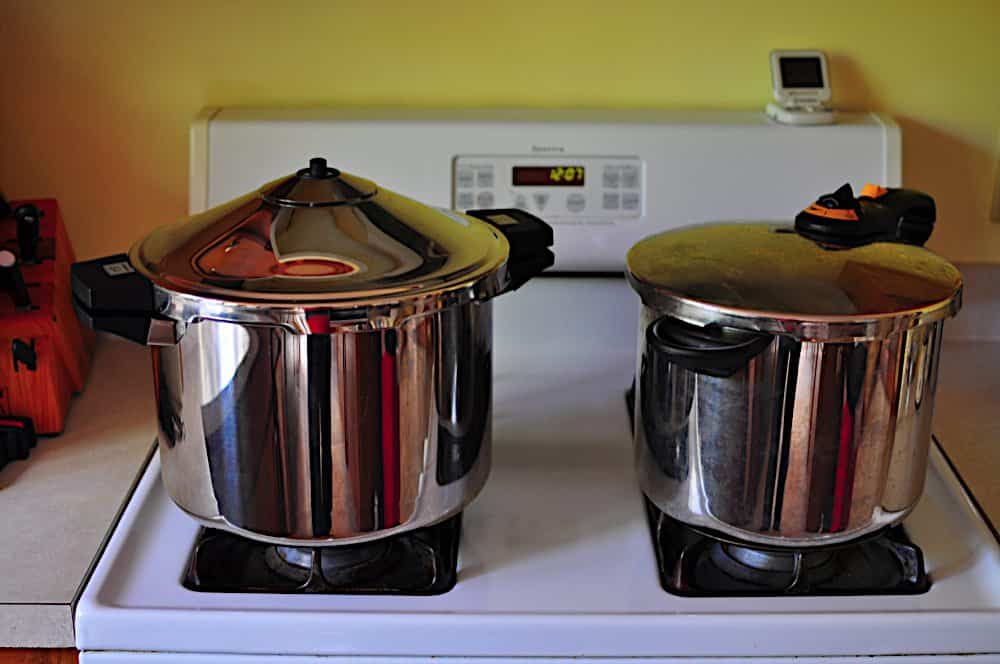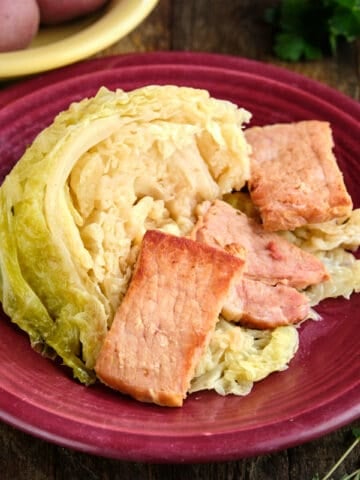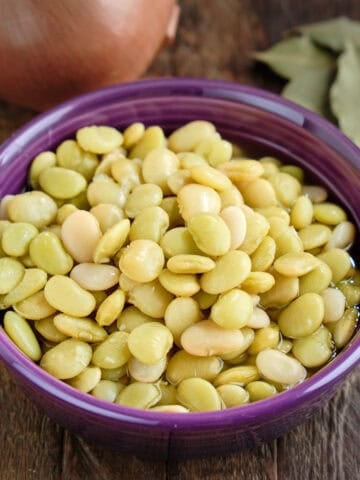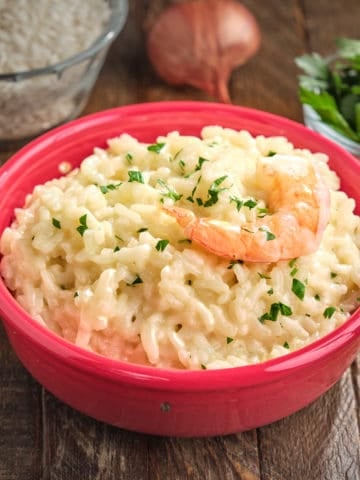Things I Love: Pressure Cooker
 |
| Kuhn Rikon 12 quart pressure cooker on the left, Fagor 10 quart pressure cooker on the right |
[Update 2016-07-12: Over the years, I've learned a lot about pressure cookers, and my preference changed to electric models. For details, see: Which Pressure Cooker Should I Buy?]
I don't think of myself as a cook who likes gadgets. My favorite kitchen tools are my knife and my wooden spoon. But there are a few gadgety* tools I use often. One of them is my pressure cooker.
*Is gadgety a word? If not, it should be.
**My rotisserie is not a gadget! It is an essential piece of grilling equipment!
I use a pressure cooker when I need to compress cooking time. When I have a recipe that says "simmer for 4 hours", but I need it done in one hour, my pressure cooker comes out. I view the pressure cooker as the time-bending opposite of the slow cooker. One is useful when you don't have much time; the other is useful when you have a ton of time.
The pressure cooker joined my batterie de cuisine years ago. It was back when Diane was pregnant with Tim, our youngest child. He decided, after only three months of pregnancy, that he was tired of waiting and wanted to join us. Diane was put on bed rest, and only allowed to get out of bed once a day for the last six months of the pregnancy. Ben was three years old, Natalie was one, and I was suddenly Mr. Mom on top of DadCooksDinner.
*After this experience, I marvel at single parents. How do they get through the daily batch of whining, late night wake-up calls, illnesses, and all the other trials that being a parent brings? When I'm tired, cranky, sick, or busy with work, I have Diane to back me up. And vice versa. In this case, I knew I just had to hang on for six months. How do you do it when you have to hang on until eighteen? If you are a single parent, and are reading this, you have my admiration and respect.
My pressure cooker helped me hold on to my sanity. Some people exercise for their mental health; I cook. With the pressure cooker, I could cook stews and chilies when I had a few minutes to myself, after the kids were in bed. I would start them while I cleaned the kitchen, and they would be done in about an hour. Then I could collapse with a good book for the rest of the evening. The next night, I would take them out of the fridge, scrape off the congealed fat, and reheat them on the stove. Dinner was ready in fifteen minutes, and I had leftovers for lunch the rest of the week. For the next six months, I worked my way through Lorna Sass's The Pressured Cook, and Ben, Natalie and I got to bond over trips to daycare and early morning ear infections. Six months later everything was back to normal.* Or as normal as things get with a new baby in the house. The pressure cooker has been in regular use in my kitchen ever since.
*The end result of the bed rest was a healthy baby, born one month early. I can't believe Tim is five years old; it seems like this happened only yesterday. He has the personality you would expect for someone who wanted to be born six months early - stubborn and determined to do things his way.
**I have no idea where he gets that from.
How does it work?
Pressure cookers use the steam from cooking to build pressure in the cooker. The lid has an airtight seal, and locks onto the top of the pot. In the lid is a regulator that will not allow air to escape until it reaches operating pressure at 15PSI (roughly 1.0 bar). Under pressure, water comes to a boil at a higher temperature, 250*F instead of 212*F. The higher temperature combined with the pressure cooks food much faster than normal. How much faster? Pressure cooking cuts simmering time by two thirds. For example, take my favorite pressure cooker recipe, homemade chicken stock. Normally, chicken stock should simmer for 4 hours. In the pressure cooker, chicken stock takes 45 minutes once you're up to pressure. Chili goes from 3 hours of simmering to 25 minutes under pressure. Pot roast? Done in an hour. Pressure has the amazing ability to compress cooking times.
What does it do well?
The downside to the pressure cooker is the lack of specific control while you're cooking. Once you lock the lid, you can't check on anything until it is done cooking. Don't pressure cook anything that takes careful timing or measuring of temperature.*
*Examples: Chicken breasts, rare beef, or anything ever described with the word "lean".
Pressure cooking is best for braises, stews, chilies, curries, pot roasts, dried beans, and soups. In other words, it is a good replacement for long, slow, wet cooking methods, where overcooking doesn't happen easily.
*If a recipe has the words "simmer for X hours" in it, then it will be perfect for the pressure cooker.
Also, because it needs steam to come up to pressure, it won't work with any recipes involving dry heat. You have to have some liquid in the pot, usually a half a cup or more.
Is it going to explode?
When I tell people I love my pressure cooker, that is always the first thing they ask. Everyone has a story about that time in the 70's when mom's pressure cooker exploded. The lid was embedded in the ceiling, pea soup coated every surface in the kitchen, and mom never used the pressure cooker again.
I know why these stories are from the 70's, but I can't explain why mom was always cooking pea soup. Those were first generation pressure cookers, often called "jiggle tops". They regulate pressure using a weighted regulator, which lifts off the pressure valve when the steam in the cooker is strong enough to lift the weight. The problem is, that valve is the only way for steam to escape. If something blocks that valve (like, say, a stray pea skin), the pressure keeps building, and building, and...boom.
*They're called jiggle tops because once they are up to pressure, the weighted regulator rocks back and forth, letting a little burst of steam out every time it rocks. And because "jiggle top" is more fun to say than "rocking top".
Starting in the 80's, European companies developed second generation pressure cookers. These cookers have spring-loaded valves to maintain the pressure. No steam escapes from the pressure cooker unless it is over-pressurized; you can tell they're up to pressure by watching the marks on the regulator. They are built with multiple safety systems and release valves, to make sure the pressure will escape before the cooker blows its lid off.
*Worst case, it will hiss and sputter a lot, until you turn off the heat. No more exploding! No more pea soup on the walls!
Which one should I get?
Obviously, you want a second generation cooker. Stay away from all-aluminum models, which are really meant for pressure canning. The brands that are recommended by sources I trust are Kuhn Rikon, WMF and Fagor. Kuhn Rikon is often called the Mercedes-Benz of pressure cookers, and it has the quality and price tag to match that description. I've also read good things about WMF pressure cookers. Both are second generation cookers, but I've never had my hands on either brand. My pressure cooker is the Fagor Duo 10 quart pressure cooker. It has the spring loaded valve and multiple safety systems of a second generation cooker, but you can tell that it's up to pressure once it begins releasing steam, like a first generation cooker. I think of it as a one and a half generation cooker. The Fagor doesn't have a marked regulator, and the constant hissing can get a little annoying.
That said, I haven't upgraded it because I love its size. The Fagor is 10 quarts, and 10 inches in diameter. This is unusual in pressure cookers; most manufacturers stop at an 8 quart capacity, and most cookers are 8 to 9 inches in diameter. And…that brings me to head space. Buy a larger pressure cooker than you think you need. A pressure cooker needs "head space" to come up to pressure - if it is filled over ⅔rds full, there isn't enough space for the steam to build up pressure. So, my 10 quart cooker only gives me 6.6 quarts of usable space. A 8 quart cooker gives you 5 quarts of space, and so on.
*I like the 10 inch diameter because it gives you extra space when you're browning meat to make a stew or braise. It's the difference between having to brown in two batches or three batches.
For that 10 quarts, the Fagor costs around $100. The only other pressure cooker I've been able to find that is 10 quarts (or larger) is the Kuhn Rikon 12 quart family pressure cooker. It is two quarts larger, has a real second generation pressure system, and it has an 11 inch diameter. Why don't I own one? Because it costs $399. I can't justify four times the price for the extra two quarts.*
*Yet. But I'm weakening. I can go an awful long way to justify a purchase when I really, really want something. Everyone seems impressed with the Kuhn Rikon cookers, and I'd love to try one out. Someday, when this blog has made me rich and famous, I'll upgrade.
**Yes, gadget lust is an ugly thing.
RTFM - Read the F(ine) Manual
Read the manual. All pressure cookers work a little differently. The manual will explain how to use the cooker, how to lock the lid so the cooker can come up to pressure, and how to release the pressure so the lid can be unlocked.
*That's another safety feature that has been added. Modern pressure cookers lock until all the pressure is released. That way, the lid can't be forced open while the cooker is still under pressure, causing the aforementioned pea soup explosion.
Pressure Cooking Sources:
My discussion of pressure cooking sources has to begin with Lorna Sass*. She is my pressure cooking guru. Her cookbooks taught to use my pressure cooker, and are resources I still turn to for timings when I'm adapting a recipe for the pressure cooker. The one I recommend to people just starting out is Pressure Perfect; it has the widest range of recipes, and timing suggestions for just about any cut of meat or bean you could think to put in a pressure cooker.
*I own all of her pressure cooking cookbooks, and started with her The Pressured Cook.
And! Part of why I'm writing this post is that I just found out that Lorna has a blog. Check out Pressure Cooking with Lorna Sass [pressurecookingwithlornasass.wordpress.com] for videos with Lorna, and links to other pressure cooker recipes around the web.
Other sources where I've found good pressure cooker recipes are:
The America's Test Kitchen Family Cookbook has a very good section on pressure cooking.
Madhur Jaffrey's Quick and Easy Indian Cooking has a lot of pressure cooker recipes; pressure cooking is very popular in India
Jaques Pepin has a few pressure cooker recipes in his Fast Food My Way and More Fast Food My Way
Alton Brown (my hero!) has done a couple of episodes using a pressure cooker: Pressure and The Big Chili
What do you think? Do you use a pressure cooker? Have any questions? Other ideas you want to share? Leave them in the comments section below.
Related Posts:
Using my pressure cooker to make stock is my "killer app" - I make chicken stock once or twice a month with my pressure cooker. After roasting a chicken for dinner, I take the carcass and toss it in the pressure cooker while I clean the kitchen. One hour later...stock!
Pressure Cooker Chicken Stock
Pressure Cooker Turkey Stock
Pressure Cooker Asian Pork with Dried Plums
Pressure Cooker Short Ribs
Inspired by:
Lorna Sass: Pressure Perfect
Fagor Duo 10 Quart Pressure Cooker
*Enjoyed this post? Want to help out DadCooksDinner? Subscribe using your RSS reader or by Email, recommend DadCooksDinner to your friends, or buy something from Amazon.com through the links on this site. Thank you!





Leslie
Great post! I also love my pressure cooker, and have made a website about using it: http://www.PressureCookerDiaries.com
I just got some short ribs from my CSA and was looking for a good pressure cooker recipe. I can't wait to try your recipe, but am still deciding if I want to go the mexican route, or the "traditional"
You've got a new subscriber 🙂
MikeV @ DadCooksDinner
@Sam Horowitz:
I'm a PC for staples kind of guy also. 50% of my pressure cooking is chicken stock or dried beans.
But this winter I've been craving comfort foods, and the PC has really helped me get quick soups and stews on the table.
Sam Horowitz
Dad cooks in my house as well. Thanks for the content. The pressure cooker is indispensable for a few staples in our house (beans, rice, etc) but I'm planning to expand my PC repertoire.
MikeV @ DadCooksDinner
@AYOTG:
You're welcome. My pressure cooker is one of my essential tools; I don't know what I'd do without it.
@Jennifer Park:
Thank you! And thank you to Fagor for making my favorite pressure cooker!
@The Veggie Queen:
Flattery will get you everywhere...
The Veggie Queen
Great post. What a smart man you are to realize that a pressure cooker is an essential piece of kitchen equipment when time is an issue.
I also have a blog http://www.pressurecooking.blogspot.com that helps people learn more about pressure cooking.
Lorna Sass and I are colleagues who support people who encourage others to get over their fear of the pressure cooker and embrace its use so save time, energy, money and people's health.
To that end, I produced a DVD on the subject, Pressure Cooking: A Fresh Look, Delicious Dishes in Minutes (for sale) and have You Tube videos (for free) at http://www.youtube.com/TheVQ.
I also use Fagor cookers since they seem most reliable and cost effective.
Thanks again.
Jennifer Park
Great post! Will be sure to tell our fans about your blog. Please check out Fagor America's Facebook fan page for more great recipe ideas!
A Year on the Grill
This is a great post for me. I do not yet own one, and always wondered the details... thanks for this